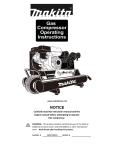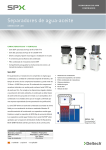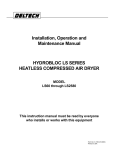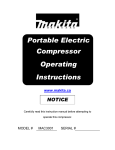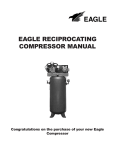Download Eagle RECIPROCATING Instruction manual
Transcript
PUMP & COMPRESSOR, LTD. INSTRUCTION MANUAL FOR EAGLE RECIPROCATING COMPRESSORS Revised: Sept 2004 TABLE OF CONTENTS Safety Precautions……………………………………………………………………………2 Cautions………………………………………………………………………………...2 Air Receiver…………………………………………………………………………….2 Safety Valve……………………………………………………………………………2 Installation and Operating Instructions………………………………………………….2 Installation……………………………………………………………………………..2 Mounting……………………………………………………………………………….2 Wiring…………………………………………………………………………………..3 Break-in Procedure……………………………………………………………………3 Before Operating the Air Compressor………………………………………………3 Compressor Lubrication……………………………………………………………...3 Filling Compressor with Oil…………………………………………………………..4 Oil Changes…………………………………………………………………………...4 Maintenance…………………………………………………………………………..4 Checking Belt Tension……………………………………………………………….4 Replacing Deltech Filter Element……………………………………………………5 Checking the Deltech filter Internal Float Valve……………………………………5 Operating Your Air Compressor………………………………………………………..…5 Compressor Maintenance Schedule…………………………………………………..…5 Troubleshooting…………………………………………………………………………..…6 Eagle Standard Warranty………………………………………………………………..…8 CAREFULLY READ THIS INSTRUCTION MANUAL BEFORE ATTEMPTING TO OPERATE THIS COMPRESSOR. SAFETY PRECAUTIONS SAFETY VALVE Please familiarize yourself with the following information to prevent damage to your compressor unit and injury to the operator. This valve is factory installed to prevent over pressurizing of the air of the air receiver. it is factory set at a specific limit for your particular model, and should never be tampered with. CAUTIONS The air compressor and motor will get hot while in operation. Never touch the discharge tubing, motor or compressor pump while in operation. The compressor operates automatically while the power is connected and turned on. Compressed air from the unit may contain hazardous fumes. Air produced by this compressor is not suitable for breathing purposes. Always use a respirator when spraying paint or chemicals, or when sandblasting. Always wear safety glasses or goggles when using compressed air. It is not practical or possible to warn you about all the hazards associated with operating or maintaining this equipment. You must use your own good judgment. AIR RECEIVER over pressurizing the air receiver could cause personal injury or material damage. To protect from over pressurizing, a factory pre-set safety valve is installed. NEVER WELD, DRILL OR CHANGE THE AIR RECEIVER IN ANY WAY. Any replacement parts should be purchased with the same specifications as the original equipment. Please contact the authorized dealer for replacement parts of specifications. -2- Adjustment by user will automatically void the warranty. DO NOT REMOVE, MAKE ADJUSTMENTS TO, OR SUBSTITUE THIS VALVE! AUTOMATIC DRAIN The unit is equipped with an airactuated automatic drain, which automatically discharges air receiver condensation each time the compressor starts and stops. Some models may have different type of drains. OIL FILTER (OPTIONAL) This is a coalescing filter, which removes oil droplets and aerosol mists from compressed air. They may also be used as a pre-filter to extend the life of your membrane dryer. All filters are equipped with internal float drains to facilitate the removal of liquid contaminants. INSTALLATION 1. Installation Proper care, maintenance and lubrication ensures longevity. The compressor should always be level for proper lubrication. Use only in a clean, dry and well ventilated area. The compressor has heat dissipation fins for proper cooling. Keep the fins and other parts that collect dust clean. Do not place rags or other materials on top of the compressor, as this obstructs cooling and can be a fire hazard. It is recommended that the compressor be operated in temperatures under 104°F. In cold climates, the compressor should be installed in a heated building. All units are shipped with pressure switches and solenoid valves to bleed off the discharge line. The solenoid would need to be wired on site to the motor starter, so that every time the motor stopped the solenoid will be deenergized and will vent the discharge line so the compressor will start at no load. Note: Any warranty claims for electrical components can only be considered when submitted with proof of proper electrical installation. 2. Mounting Mount the compressor on a concrete pad or solid floor, making certain that the air receiver feet are level and that no stress is placed on the legs when the mounting nuts, if used, are tightened. Shim feet if necessary. Severe vibrations will result when feet are uneven and drawn tightly to the floor, which can lead to welds cracking or fatigue failure of the air receiver. 4. Break-in Procedure 1. Open the air receiver’s drain valve or outlet valve. 2. Run the compressor for a minimum of twenty (20) minutes in no-load condition to lubricate the bearings and pistons. 3. Close the air receiver drain valve and the outlet valve. Your compressor is now ready for use. 4. After 24 hours of operation check Vbelt for proper tension. Check that the compressor pulley and motor sheave are aligned and fastened securely (see items 9 and 10). 5. Nuts and bolts may loosen. Retighten when necessary. 6. Compressor oil may turn black. This is normal. Change after 100 hours. The compressor must not be installed closer than 18” to a wall or another compressor. ALMOST ALL WELD CRACKS OR FATIGUE FAILURES ARE CAUSED BY IMPROPER INSTALLATION AND ARE NOT COVERED BY WARRANTY. 3. Wiring REGULATIONS REQUIRE THAT ALL WIRING BE DONE BY A LICENSED ELECTRICIAN, FAILURE TO DO SO COULD VOID YOUR WARRANTY 5. Before Operating the Compressor, Please Check Following Carefully Air the 1. Check to see that nuts and bolts are all snug. 2. Check if the quantity and quality of oil is correct. 3. If the intake filters are dirty, they should be replaced or cleaned. 6. Compressor Lubrication ALWAYS CHECK THE OIL LEVEL AND QUALITY BEFORE START-UP. DO NOT ADD OR CHANGE OIL WHILE THE UNIT IS RUNNING. USE ONLY RECOMMENDED NON-DETERGENT OIL. -3- Recommended Oil: 9. Maintenance Eagle Compressor Oil: #EAOIL10 (1L) #EAOIL40 (4L) * Compressor originally SAE20W Oil (ISO 68) filled Before doing any maintenance or adjustments to your air compressor, the following safety precautions should be taken: with 1. Turn off and lock out electric power. 2. Drain air receiver and air lines of air pressure. Eagle compressor oil is a non-detergent mineral oil formulated with additives to help minimize carbon build-up, increase ring life and reduce oil consumption. It is for use at ambient temperatures of 0° to 30° C (32° F - 86° F). 10. Checking Belt Tension Adjust belt(s) so when pressure is applied at the center, there is approximately ½” slack (see diagram below). Other approved Oils: Regular mineral oils can also be used in Eagle compressors. If the belt is installed too tightly, the motor might be overloaded. This will cause the motor to overheat. If the belt is installed too loosely, it will slip and excessive wear and vibration will occur. Always use a non-detergent oil with the following specifications: Ambient Temperatures at Point of Operation -16°C to 0°C (3.2°F - 32°F) 1°C to 26°C (33.8°F - 78.8°F) Above 27°C (80.6°F) SAE Viscosity ISO Viscosity SAE 10W ISO 32 SAE 20W ISO 68 SAE 30W ISO 100 7. Filling Compressor with Oil How to Install a New Belt if Required 1. Remove the oil filler plug. 2. Slowly pour the proper oil into the pump crankcase. 3. Always keep oil level in the middle of the sight glass. 1. Disconnect power supply. 2. Remove belt guard. 3. Loosen motor bolts an slide motor toward compressor head just enough to allow the old belt to be removed. 4. Install the proper replacement belt. 5. Slide motor away from compressor head to provided recommended tension as shown in the above diagram. 6. Align belt using a straight edge ruler against pulley’s edge. 7. Fasten motor bolts. 8. Ensure motor and compressor pulleys are secure. Re-check alignment. 9. Re-install belt guard and reconnect power supply. 8. Oil Changes Initial oil change is due at 100 hours. Change the oil every 300 hours or 3 months, whichever comes first 1. Remove the oil drain plug. Allow oil to drain completely. 2. Replace the oil drain plug. 3. Refill with the recommended oil to the proper level. -4- 10. Belt tension should be checked after 20 hours of operation. Check tension monthly thereafter. 11. Replacing Deltech Filter Element (if equipped) The recommended element change out is once a year or when the indicator changes to red. 12. Checking the Deltech Filter Internal Float Drain Valve Inspect the internal float valve every two to three weeks for excessive oil and water by pressuring the test valve on the bottom of the filter unit. If more than one or two drops of oil leak out, the drain valve should be cleaned or replaced. OPERATING YOUR AIR COMPRESSOR EXTRA CARE SHOULD BE TAKEN TO AVOID PERSONAL INJURIES WITH AUTOMATIC CONTROLLED COMPRESSORS 1. Check unit for any damage. All compressors are tested and inspected at the factory and supplied in perfect condition. Any damage is the freight carrier’s responsibility and you must notify the freight company immediately upon discovering any damage, and submit a claim. Ensure you have documented the damage on the waybill receipt if possible. 2. Check compressor installation and wiring and perform a “break-in” run as per item 4. 3. Turn on the electric power. The compressor should start running and air pressure should build up in the air receiver as evidenced by the air receiver pressure gauge. Make sure drain valve and outlet valve are closed. 4. When the air receiver pressure reaches the pressure switch cut-out pressure, the compressor should stop automatically and you are now ready to start using the compressed air. As air is used, the pressure in the air receiver will drop and cause the pressure switch to close and this will automatically start the compressor. COMPRESSOR MAINTENANCE SCHEDULE Daily or Before Each Use • Check oil level • Drain condensation from air receiver • Check for any unusual noise or vibration • Be sure all nuts and bolts are tight Weekly • Turn off power. Clean dust an foreign matter from cylinder head, motor, fan blades, intercooler and air receiver • Clean air filter by opening air filter, removing filter element and cleaning it thoroughly with soapy water. Rinse thoroughly and allow to dry completely before assembly • Worn filters should be replaced • Check V-belts for wear Monthly • Inspect unit for leaks • Tighten joints if leaks are observed • Check V-belts for proper tension • Check compressor pulley and motor sheave are aligned and securely fastened (see item 9) Quarterly or 300 Hours (whichever comes first) • Inspect the air receiver for corrosion or other damage • Change compressor oil • Replace air filter (more often if compressor is used near paint spraying operations or in dusty environments) -5- TROUBLE SHOOTING PROBLEM Will not start Low pressure Oil in discharge Compressor overheats POSSIBLE CAUSE • Incorrect power supply and/or wiring • • • • • • • • • • • • • Air receiver is at full pressure Safety valve leaks Drain cock open Loose tubes or fittings Dirty or plugged air filter Defective unloader valve Improper oil viscosity Too much oil in the crankcase Compressor overheated Restricted air filter Worn piston rings Clogged inlet filter Dirty compressor, head, cylinder or intercooler Operating pressure too high Low oil or wrong oil being used Compressor cycle too long, proper cycle is 50-60% on stop/start operation Leaks in air system Pressure switch differential adjusted too close • • • Compressor loads and unloads or stops and starts excessively Insufficient output Low discharge pressure • • • • • • • • • • • • • • • • Defective compressor valves Compressor too small for intended use Clogged inlet filter Leaks in air lines, air valves, fittings, etc. Drive belts slipping Drain valve left open Defective pressure gauge Compressor incorrectly sized Leaking head gasket Dirty or plugged inter cooler tubes Pressure switch adjusted too low, or defective Worn or defective compressor valve Worn piston, worn out rings Restrictive check valve -6- CORRECTIVE ACTION • • • Make sure power is turned on Consult with a licensed electrician Drain air receiver • • • • • • • • • • • • Replace safety valve Close drain cock Tighten fittings Clean or replace as necessary Replace unloader valve Drain and replace oil Drain oil and fill to proper level Air pressure regulated too high Clean or replace air filter Replace piston rings Clean or replace as necessary Clean with compressed air • • • Reduce operating pressure Drain and replace oil Allow for longer rest between cycles • Replace worn components as necessary Make necessary adjustments Replace valves • • • • • • • • • Clean or replace as necessary Replace worn components as necessary Tension V-belts close drain valve Replace pressure gauge • Replace head gasket Remove and clean inter cooler tubes Make necessary adjustments • Replace valves • • Replace worn parts Clean check valve and replace if necessary Motor stalls or blow breaker Water in crankcase oil gets dirty, rusty valves or cylinders • • • • Faulty check valve Valves incorrectly installed Drive belts too tight Defective motor • • • • • • Defective pressure switch Power being supplied by generator Cycle too short - compressor does not operate long enough to vapourize condensed moisture during compression System pressure leaking back through check valve when compressor is stopped Wrong oil being used • • Loose compressor, motor, engine or guard Compressor not level Feet bolts over tightened to floor Excessive discharge pressure Wrong oil being used Loosen flywheel, drive pulley or drive belts Worn connect rods, wrist pin or main bearings Compressor valves loose or broken Inspect check valve, it may knock at low pressures Clogged inlet filter • Wrong oil being used, wrong viscosity Oil level too high • Crankcase breather valve malfunction Compressor runs unloaded too long • Compressor operating outside in cold conditions or inlet filter not protected against weather Worn piston rings Piston rings not seated Allow 100 hours of normal operation for new rings to seat Drain oil and refill with Eagle EAOIL or other approved oils • • • • Excessive vibration/ compressor knocks • • • • • • • • • Compressor uses too much oil • • • • • • Piston rings not seated • • • • -7- Replace check valve Install valve correctly Tension V-belts Consult licensed electrician/ replace motor Replace switch Consult licensed electrician • Allow for a longer operating cycle • Check and replace check valve if necessary • • Drain and replace with proper oil Tighten components • • Level compressor Loosen feet bolts • • Reduce operating pressure Drain and replace with proper oil Tighten loose components and check belts Check and replace worn parts • • • • • • • • • • Check and replace worn or broken valves Remove and clean check valve Clean inlet filter or replace if necessary Drain and replace oil Fill compressor with oil to proper level Replace crankcase breather Increase load or stop compressor when not needed (check for air/leaks) Provide adequate protection against extreme weather conditions Replace piston rings See instruction below Allow 100 hours of normal operation for new rings to seat Drain oil and refill with Eagle EAOIL or other approved oils EAGLE STANDARD WARRANTY EAGLE PUMP & COMPRESSOR, LTD. STATIONARY RECIPROCATING PRODUCTS Seller warrants products of its own manufacture against defects in workmanship and materials under normal use and service as follows: COMPRESSORS: Twelve (12) months from date of start-up, or Fifteen (15) months from date of shipment from factory, or whichever comes first PARTS: Ninety (90) days from date of sale Eagle warrants repaired or replaced parts for its own manufacture against defects in materials and workmanship under normal use and service for ninety (90) days or the reminder of the warranty on the product being repaired, whichever is longer. With respect to products not manufactured by Eagle, Eagle will, if practical, pass along the warranty of the original manufacturer. Notice of the alleged defect must be given to the Seller in writing with all identifying details including serial number, model number, type of equipment and date of purchase, within thirty (30) days of the discover of same during the warranty period. Eagle’s sole obligation on this warranty shall be, at its option, to repair, replace or refund the purchase price of any product or part thereof, which proves to be defective, F.O.B. Eagle shop. If requested by Eagle, such product or part thereof must be promptly returned to Eagle, freight prepaid for inspection. This warranty shall not apply and Eagle shall not be responsible nor liable for: a. Consequential, collateral or special losses or damages; b. equipment conditions caused by normal wear and tear, abnormal conditions of use, accident, neglect or misuse of equipment, improper storage or damages resulting during shipment; c. deviation from operating instructions, specification or other special terms of sale; d. labour charges, loss or damage resulting from improper operation, maintenance or repairs made by person(s) other than Eagle or Eagle authorized service representative; e. improper application of product. In no event shall Eagle be liable for any claims, whether arising from breach of contract or warranty of claims of negligence or negligent manufacturer, in excess of purchase price. This warranty is the sole warranty of Eagle and any other warranties, expressed, implied in law, or implied in fact, including any warranties of merchantability and fitness for particular use, are hereby specifically excluded. -8- 403-253-0100 www.eagle-pc.com














